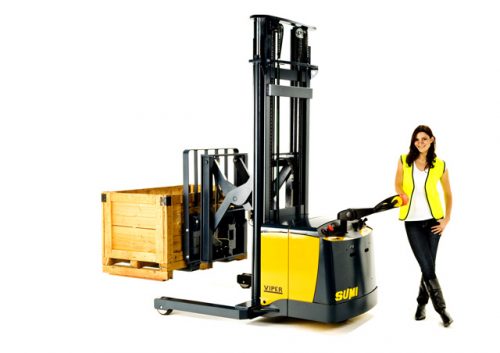When you start to look at forklifts there are so many different types shapes and sizes out there on the market. One class of forklift is more unique then most, the pedestrian operated forklifts range.
What makes then unique in Australia is the fact that you do not need a high-risk work license, which means it becomes easier for businesses to train their operators on how to use them, as well being a cheaper option for a business to consider.
Types of Pedestrian Operated Forklifts
There are a wide range of pedestrian operated forklift in this range including the walk behind pallet jack and walk behind stacker range.
Walk Behind Pallet Jack
Very much like a manual pallet jack, there are also battery electric operated pallet jacks. Ranging from a small 1500 kg Battery electric walk behind pallet jack through to a 3000-kg walk behind battery operated pallet jack, as well as ride on models.
As we construct bigger and bigger warehouses, ride on pallet jacks are becoming increasingly common with both end rider types and side standing types of pallet jacks, being used. As it allows the operator to ride with the pallet jack and load over greater distances very quickly.
Of course, there is also the Sit on Pallet Jack as well. Again, very useful for when pallets need to be moved greater distances in large warehouses.
Types of Walkie Stackers
There are many different types of walkie stackers, the best way to describe them is, if you think a battery electric pallet jack with a mast you wouldn’t be far wrong.
Walk Behind Straddle stacker
The most common type of walkie stacker with general capacities ranging from 1200 kgs through to 1600kg, and lift heights from 2500mm to 4500mm.
The mast will only travel straight up and down, they are designed so they have outrigger legs so they can straddle a pallet, as well act as a stabilizer.
There are also leg over walkie stackers where they are designed for special pallets that don’t have a bottom board configuration like the popular Australian Chep Pallet.
Walk behind Reach Stackers
The walkie reach stacker is growing in popularity with the ability for the carriage to reach out in front of the machine. So, it can pick up and move a pallet jack back toward the operator.
This type of function is very popular when needing to unload trucks or pick up a pallet that might be a little out of reach.
The walkie reach also has stability legs protruding from the front of the forklift,
Walkie behind counter balanced stacker
These types of walkie stackers are longer than normal as they don’t have stability legs out the front, they have more counterweight in the back of the unit to counterbalance the load.
The benefits of Pedestrian Operated Forklifts
No Forklift Ticket Required
Despite popular opinion there is currently no forklift license required to operate a walkie behind forklift at all.
All that is required is familiarization training given to the operator which is usually a short 15-minute run down on how to operate the walkie stacker.
This makes these type of pedestrian operated walk behind forklift very popular, in the back of loading docks where younger people are employed. Such as a supermarket that employ school children after school hours.
Lower maintenance cost
Due to the nature and design of these types of forklifts there is less maintenance required on a pedestrian operated walkie then a ride on 2.5T Internal combustion forklift.
They are designed with electric drive motors, and usually come with a large type industrial battery. As always, we recommend servicing as per the manufacturers recommendation.
Reduces manual handling
Especially the pedestrian battery electric pallet movers, if your business needs to move pallets around a warehouse. Instead of your employee moving 2 ton pallets with a manual pallet jack you can use a battery electric pallet mover to move them from A to B.
This reduces the need for the operator to physically move pallets around with a manual pallet jack, reducing the manual handling effort and the likely hood of back strain.
The Limitation of Pedestrian Operated Walkies
Limited lift heights
Due to the design limitations of walkies particularly the walkie stacker range. The Mast lift heights are limited to how high you can go.
Although in both a 2 stage and 3 stage configurations, they will generally lift no higher than 5000mm. If you are wanting to lift higher, then that you need to consider a ride on reach truck.
Tiller Handle
Designed with an operator tiller handle, when operating in a tight space this can sometimes take a knock that can damage the handler. Or if operating in a tight area, it can be difficult for the operator to maneuver around.
Which way should you go
In deciding which walkie, you should go for your business, it depends on what type of warehouse you have. Talk to your local forklift dealer about what is the best option for your business.

